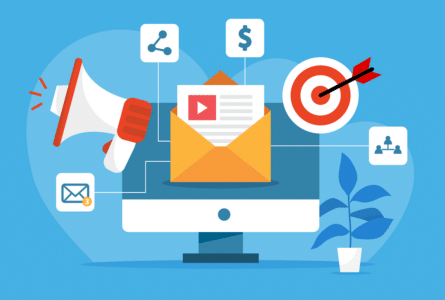Newsletters have proven their performance and it looks like the newsletter is a more than legitimate tool to highlight content and strengthen relationships with prospects.
In order to take advantage of this powerful communication channel, it is essential to take the following steps:
#1
SET CLEAR GOALS AND DEFINE YOUR ROADMAP
To ensure optimum open and conversion rates, your newsletter must be in line with your marketing strategy. What is your primary goal? Some common objectives include:
- Driving highly qualified traffic to your website
- Increasing your online presence
- Improving your image
- Acquiring sales leads
- Converting prospects into customers
- Generating direct sales
- Building customer loyalty
- Using a promotional action to make prospects want to buy
- Communicating relevant news and content
- Helping your customers learn how to use your products and services
- Event invitation
- Etc.
By defining a clear goal first, you will give yourself the means to integrate the key steps of your newsletter strategy into a more coherent roadmap.
#2
TARGET YOUR AUDIENCE
In order to avoid any confusion, it is necessary to identify precisely who you wish to address with your communication. It is important to ask yourself... Who is your target? What do they need? Do they expect advice? How can you reassure them? What topics related to your activity are likely to interest them? Do you have multiple audiences and need to segment your contacts into different groups to offer them adapted content?
This strategic segmentation is crucial to ensure good performance in terms of open and conversion rates. The idea is to divide your contacts into subgroups with specific criteria (classification by demographic, center of interest, date of first purchase, frequency of purchases, behavior observed during their visit to your website, pages visited or links clicked, etc.). This will give you a strong indication of what content to deliver to each of your audiences.
You can facilitate the segmentation of a list of contacts by setting up a registration form for your newsletter directly on your website. This form is the opportunity to obtain, in addition to an email address, other information about the subscribers such as their last name, first name, gender, date of birth, interests, desired frequency for receiving content, etc. This method of collecting addresses is called "opt-in”.
#3
OPTIMIZE YOUR NEWSLETTER TO MAKE IT DELIVERABLE
While targeting your audience is essential, deliverability will also play a key role in the success of your newsletter. If it turns out that it is perceived as spam by email providers and doesn’t arrive in the main inbox of recipients, all of your marketing efforts will be for nothing.
To avoid this, it is essential to implement certain practices.
- Regularly clean your contact database (deleting erroneous or inactive addresses) because artificially inflating it is unproductive.
- Use an email address that is identifiable with your domain name.
- Take care with your newsletter’s title and pre-header (it should be attractive but not overly commercial, ideally less than 60 characters and customization should be favored).
- Avoid using "spam words" that may contribute to the non-receipt of your newsletter.
- Ensure compliance with the General Data Protection Regulation (GDPR) including obtaining each contact’s explicit consent to receive your emails, providing an unsubscribe link, the right to modify data, etc.
- Test your newsletter by sending it initially internally (check the display and the successful reception via different types of email providers, check the links and landing pages, etc.) and make the necessary corrections.
#4
DEFINE YOUR EDITORIAL APPROACH
Even if your goal is, directly or indirectly, commercial, it is important to ensure that your content is rich and attractive . What level of content do you want to convey to your readers? What can you provide them with? How can you address their issues? This is the time to think about content that brings real added-value in order to ensure your communication is read and engages interest, while remaining on topic in the context of your business. The idea is also to define your editorial approach around the different target audiences you identified because they will not be reached with the same type of content.
Do you have writer’s block when faced with the blank page? There is no shortage of topics to cover to create a connection with your target audience and reassure them. Here are a few:
- Reflection on a general or current topic.
- A new product
- Expert info
- Product tips
- An innovative service
- New trends
- An important announcement (i.e. a product update, special offer, discount, trial offer, etc.).
- A success story or customer testimonial
- Communication on your environmental, social or societal values
- A webinar invitation
#5
WORK ON YOUR NEWSLETTER IDENTITY AND FORMAT
Your communication should be directly inspired by the tone inherent in your company's marketing strategy. What type of wording is linked to your company’s identity? How do you usually address your audience? What image of your company do you want to project?
While content is fundamental, the form you give your newsletter is also very important. Your company or brand’s visual identity must come out in your newsletter. Do not hesitate to use all of your visual codes: logo, colors, font (as long as they are compatible with all browsers).
The format of your newsletter should always be thought of in terms of "responsive design" so that it adapts to display correctly according to the device used by the prospect (i.e. computer, smartphone, tablet).
In any case, a clear, polished layout; quality visuals; a trendy and uncluttered design and information in the right order are assets. Cluttered newsletters can actually make you lose readers. It is important tograb their attention as much as possible! Adding buttons like "Discover the range," "Read more," "Read the full article," etc. will give recipients the option of quickly browsing your newsletter to identify the topics they like and continue reading on your website, if necessary.
#6
GET YOUR CONTACTS TO TAKE ACTION
The newsletter is a great tool to create connections, but it is still necessary to encourage recipients to contact you, to participate in a dialogue, to take action and why not to speak up.
Would you like to know what your contacts really think of your products or your company? Use your newsletter to solicit suggestions for your products or services, or to conduct surveys.
Do you want to create a special bond with your prospects? Personalize the subject of your newsletter by using the first name of your recipients, humanize your communication. And even if you are not sure of your choice, of which object to use for example, you always have the option of doing A/B testing, i.e. testing 2 different titles on a reduced sample of recipients in order to identify the one generating the most engagement, then using it for the whole target audience.
In order to let your contacts know the reason for your newsletter and to create a bridge between you, your newsletter must naturally lead to a Call-to-Action or CTA button. Actions include making a purchase, downloading, sharing content, subscribing and requesting a quote, trial, or being contacted. Visually attractive, striking, personalized, incentive-based CTAs that are cleverly positioned in your newsletters guarantee conversion. To encourage clicks, the CTA must appear as an action verb, evoke urgency or scarcity and propose only one action (i.e. "Try it now," "Download now," "Subscribe today,” etc.). But originality sometimes pays off, so feel free to stray from the beaten path!
#7
SPECIFY THE SENDING CALENDAR AND FREQUENCY
Even if there is no hardfast rule, it is recommended to identify the best day and time to send your newsletter in order to solicit your prospects when they are potentially most reactive.
It is also important to pace sending newsletters and identify a happy medium in terms of frequency. Don't bore your audience with too much repetition and don't fall into the opposite excess by remaining absent from their daily lives for too long. It’s a question of ensuring regular, non-intrusive newsletters, of not over-soliciting your audience while maintaining a recurring presence (i.e. weekly, bi-monthly, monthly, etc.) in order to establish expected communication.
The form for signing up for your newsletter is a good way to give your contacts the option of choosing the frequency and type of content they wish to receive. This will improve the quality and engagement of your audience.
#8
MEASURING YOUR PERFORMANCE WITH 5 INDICATORS
To check if your B2B newsletter strategy has been effective, you can analyze existing KPIs (Key Performance Indicators). This type of indicator can help you determine your audience’s engagement and whether your newsletters have reached the marketing objectives you initially set.
The 5 main KPIs you should know:
- The deliverability rate (proportion of newsletters that have reached the main mailbox of the targeted contacts).
- The open rate (percentage of people who opened the newsletter out of all those who received it).
- The click-through rate (percentage of people who clicked on a link in the newsletter out of all the contacts who received it).
- The conversion rate (percentage of people who took a concrete action - purchase, subscription, download, etc. - after receiving the newsletter).
- The unsubscribe rate (percentage of people who unsubscribed from the newsletter).
Ready for an adventure?
Take action and build an expert image on your market with your BtoB newsletter. It will not only allow you to generate leads, but also to create lasting relationships with your readers!










